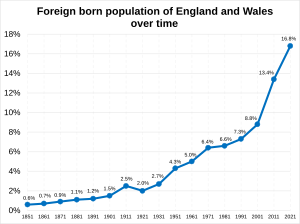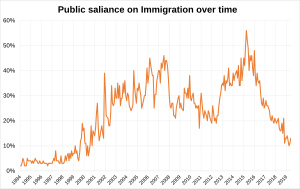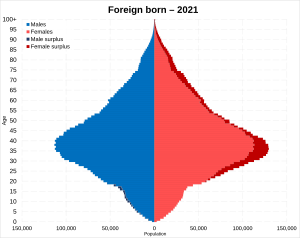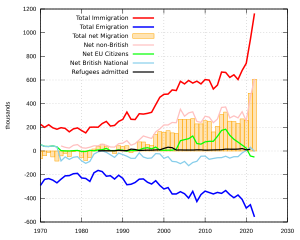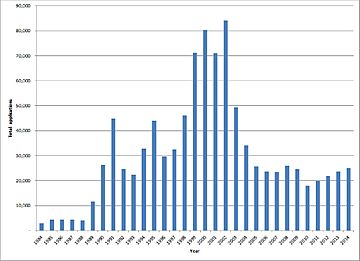Modern immigration to the United Kingdom facts for kids
Since 1945, many people have moved to the United Kingdom. This movement is called immigration. Rules about who can enter are set by British immigration law. Many immigrants came from the Republic of Ireland and countries that used to be part of the British Empire. These include India, Bangladesh, Pakistan, the Caribbean, South Africa, Nigeria, Ghana, Kenya, and Hong Kong.
When the UK joined the European Communities in the 1970s and the European Union (EU) was created, people from EU countries could move freely. This was one of the EU's "Four Freedoms". After Brexit in 2021, EU citizens no longer have an automatic right to live in the UK permanently. Some people also come to the UK as asylum seekers. They seek protection as refugees under a United Nations agreement from 1951.
Between 2001 and 2011, about 70% of the UK's population growth was due to immigration. In 2011, 7.5 million people (about 1 in 8) living in the UK were born overseas. In 2013, 526,000 people arrived in the UK to live, while 314,000 left. This meant 212,000 more people moved into the UK than left.
Between April 2013 and April 2014, about 560,000 immigrants arrived. This included 81,000 British citizens and 214,000 from other EU countries. Around 317,000 people left the UK. The main countries people arrived from were China, India, Poland, the United States, and Australia. In 2014, about 125,800 foreign citizens became British citizens. The main countries of origin for these new citizens were India, Pakistan, the Philippines, and Nigeria.
Since 2004, more people have moved to the UK from Central and Eastern Europe. This happened when eight new countries joined the EU. The EU allows people to move freely for work. In 2008, the UK started a new points-based system for people from outside Europe. In 2022, net migration to the UK reached a record high of 606,000 people. Around 114,000 people came from Ukraine and 52,000 from Hong Kong.
Contents
- What is Immigration?
- Immigration During World War II
- British Empire and Commonwealth Immigration
- Post-War Immigration (1945–1983)
- Immigration and the EU (1983–2022)
- Expulsion of Criminals
- Immigration Rules and Laws
- Managed Migration
- Refugees and Asylum Seekers
- Illegal Immigration
- Immigration in European Union Countries
- Becoming a British Citizen
- See Also
What is Immigration?
According to the House of Commons Library, there are a few ways to define a migrant in the UK:
- Someone born in a different country than where they live now.
- Someone whose nationality is different from the country they live in.
- Someone who moves their main home to another country for at least a year.
Immigration During World War II
Before World War II, many people from Germany came to the UK. This included Jews who were being treated badly under Nazi rule. About 50,000 people were able to come. There were limits on how many could enter. When the UK declared war on Germany, people stopped moving between the two countries.
British Empire and Commonwealth Immigration
After the Second World War, the British Nationality Act 1948 was passed. This law allowed people from the British Empire to live and work in the UK without a visa. This was not what the law was originally meant to do. However, it led to many people moving to the UK.
This migration was first encouraged to help fill job openings in the UK. There was a need for both skilled and unskilled workers. This included jobs in public services like the new National Health Service. Many people came by ship, like the famous Empire Windrush in 1948.
Immigration from Commonwealth countries grew a lot. Most of these people were moving for work. The number went from 3,000 per year in 1953 to 136,400 in 1961. Because so many people were arriving, the government started looking for ways to control immigration.
The Commonwealth Immigrants Act 1962 was passed to control this. It meant migrants needed a job before they arrived. They also needed special skills or to fill a "labour need". Later, in 1968, the Commonwealth Immigrants Act 1968 was passed. This law required migrants to have a "strong connection" to the UK. This meant being connected by birth or family to a UK national.
By 1972, with the Immigration Act 1971, only people with work permits could enter. Also, people with parents or grandparents born in the UK could enter. This greatly reduced immigration from Commonwealth countries. However, the government allowed 27,000 people from Uganda to come to the UK. They were forced out of Uganda by Idi Amin in 1971.
In the 1970s, about 72,000 Commonwealth immigrants settled in the UK each year. This number went down in the 1980s and early 1990s. It then rose again by 1999. Since 1962, about 2.5 million Commonwealth immigrants have come to the UK. The Ireland Act 1949 says that citizens of the Republic of Ireland are not seen as foreign citizens in the UK.
Post-War Immigration (1945–1983)
After the Second World War, many people from areas controlled by the Soviet Union settled in the UK. This included Poles and Ukrainians. The UK invited displaced people to work in industries. This helped the country recover after the war. In 1951, there were about 162,339 Polish-born people in the UK.
Indians started arriving in large numbers after India became independent in 1947. Many worked as bus drivers or in factories. More Indians came between 1965 and 1972. This was especially true when Idi Amin expelled 50,000 Gujarati Indians from Uganda. About 30,000 Ugandan Asians moved to the UK.
After Pakistan became independent, more Pakistanis came to the UK. Many came in the 1950s and 1960s. They were invited to fill job shortages after the war. As Commonwealth citizens, they had many British rights. They found jobs in textile factories and car production. They often worked night shifts.
Many people also came from East Pakistan (now Bangladesh). In the 1970s, many East African-Asians came from Kenya and Uganda. Most of them already had British passports. There was also an arrival of 20,990 refugees from Hungary after the 1956 revolution.
Until 1962, all Commonwealth citizens could enter the UK freely. The Commonwealth Immigrants Act 1962 changed this. It made it harder for some Commonwealth citizens to enter. By 1972, only people with work permits or family connections to the UK could enter. This greatly reduced new immigration from Commonwealth countries.
Immigration and the EU (1983–2022)
The British Nationality Act 1981 was passed in 1983. It made a difference between British citizens and citizens of British Overseas Territories. It also changed how British nationality could be passed down. Immigration officers check a person's nationality and identity. They can refuse entry if they are not sure.
During the 1980s and 1990s, many Somali immigrants came to the UK. This was due to the civil war in Somalia. Most of these early migrants were given asylum. Later, in the 1990s, they often got temporary status. Some Somalis also moved to the UK from the Netherlands and Denmark. They wanted to reunite with family and find better jobs.
Non-European immigration increased a lot from 1997. This was partly because a rule making it harder for UK residents to bring foreign spouses was removed. A former government adviser said that from 2000 to 2008, the government aimed to increase migration to the UK.
In 2012, new rules were made for non-EU spouses and children. These rules required a strict minimum income for them to stay in the UK. The Supreme Court later said these rules needed to consider the interests of children more. They also said other sources of money should be looked at.
The number of foreign-born people in the UK grew from 5.3 million in 2004 to nearly 9.3 million in 2018. In the decade before 2018, more non-EU migrants came than EU migrants. However, the number of EU migrants grew faster. EU migrants were less likely to become British citizens than non-EU migrants.
In 2021, it was thought that almost 1.3 million foreign-born people left the UK. This was between July 2019 and September 2020. It was partly due to job losses from the COVID-19 pandemic. Some people also said that Brexit was a big reason for leaving.
Immigrants from the European Union
One of the main ideas of the European Union (EU) was the free movement of workers. This meant people from EU countries could move and work freely in other EU countries.
When the EU grew in 2004, the UK accepted immigrants from Central and Eastern Europe. Many other EU countries limited new arrivals from these states for a while. The UK uses surveys to predict migration numbers. However, some groups have said these surveys are not always accurate.
Research shows that between 2004 and 2009, 1.5 million workers moved from new EU countries to the UK. But many later returned home. Migration from Poland often became temporary. In 2009, for the first time, more people from the eight Central and Eastern European states left the UK than arrived.
The government said different rules would apply to people from Romania and Bulgaria when they joined the EU in 2007. Restrictions were put in place to limit migration to students, self-employed people, and highly skilled workers.
In 2011, Ed Miliband, the leader of the Labour Party, said allowing unlimited immigration from Eastern Europe was a mistake. He felt they had not expected so many people to come. He also thought it had a negative effect on wages.
Research found that EU migrants were often younger and better educated than the local population. They were also less likely to claim benefits or live in social housing.
Expulsion of Criminals
Between 2007 and 2010, about 4,000 to 5,000 immigrants who had committed crimes were removed from the UK each year.
Immigration Rules and Laws
In 1914, a law called The Alien Restrictions Act was passed. This law put limits on foreign nationals entering and staying in the UK. After World War I, this law was kept. Over time, many more rules were added to control immigration.
The Immigration Act 1971 set out rules for how immigration should be managed. In 1972, the first proposed Immigration Rules under this act were introduced. These rules caused some debate. By 2018, the Immigration Rules were very long and detailed. They were so complex that people often needed a lawyer to understand them. More than 1,300 changes were made to the rules in 2012 alone.
Managed Migration
"Managed migration" refers to legal work and student migration from outside the European Union. Many immigrants who come this way have skills that are needed in the UK. This area of immigration is handled by UK Visas and Immigration.
In 2006, changes were suggested to create a single points-based immigration system for the UK. This system gives points for things like age, education, and earnings. It was put into place in 2008.
The points-based system has five levels:
- Tier 1: For highly skilled people who can help the economy grow.
- Tier 2: For skilled workers with a job offer, to fill job gaps.
- Tier 3: For a small number of low-skilled workers needed for temporary jobs.
- Tier 4: For students.
- Tier 5: For temporary workers and young people who can work in the UK for a limited time.
In 2010, the government put a temporary limit on immigration from outside the EU. This was to stop a rush of applications before a permanent limit was set. Some people argued that this limit was bad for British businesses and scientific research.
For family members of people from the European Economic Area living in the UK, there is a special permit. This allows family members to join their relatives already living and working in the UK.
Refugees and Asylum Seekers
The UK has signed international agreements to protect refugees. This means the UK must offer safety to people who seek asylum and meet the legal definition of a refugee. The UK also cannot send a displaced person back to a place where they would be in danger.
The issue of immigration has been a big political topic since the late 1990s. Both the Labour and Conservative parties have suggested policies that seem "tough on asylum". Some media often write about an "immigration crisis".
Critics say this is unfair and that the UK should uphold its international duties. They are also concerned about how people are held in detention. They worry about families being raided and children being held in detention centers for long periods. The government had planned to stop detaining asylum-seeking children. However, they later said they would try to reduce it, not end it completely.
Some critics of the UK's asylum policy point to the "safe third country" rule. This rule says asylum seekers should apply in the first safe country they reach. Research shows that most asylum seekers in the UK did not choose the UK themselves. Their destination was chosen for them by others.
In 2003, Prime Minister Tony Blair promised to cut the number of asylum seekers by half. This goal was met. Official figures showed that the number of people claiming asylum in the UK was at a 13-year low by March 2006.
The UK hosts many Iraqi refugees. Most of them are Kurdish. Asylum seekers have sometimes been kept in detention even after courts ordered their release. In other cases, vulnerable asylum seekers are released with nowhere to live. In 2018, a law that allowed homeless detainees to apply for housing was removed. Charities say this affects about 2,000 detainees each year.
In August 2020, reports showed that over 4,000 people had crossed the English Channel in small boats that year. This caused tension between the UK and France. In August 2021, the UK government started a new program to resettle 20,000 Afghan refugees over five years. The UK also has other resettlement schemes.
Illegal Immigration
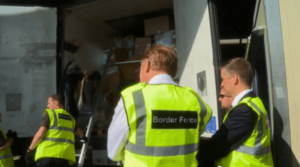
Illegal immigrants in the UK include people who:
- Entered the UK without permission.
- Used fake documents to enter.
- Stayed longer than their visa allowed.
It is hard to know exactly how many people live in the UK illegally. A 2005 study estimated between 310,000 and 570,000. Most irregular migrants have committed administrative offences, not serious crimes.
In 2006, it was suggested there could be around 500,000 illegal workers. There was a call for a public discussion about whether to offer them an amnesty. Some studies suggested an amnesty could bring in a lot of tax money for the government. It has been suggested that deporting all illegal immigrants could take 20 years and cost a lot of money.
In 2008, the government introduced new fines for employers who hire illegal immigrants. These fines could be very high. Women who are illegal immigrants and victims of domestic violence risk being deported if they report the violence. This means they might be afraid to report crimes.
Immigration in European Union Countries
In 2010, 47.3 million people living in the European Union were born outside their resident country. This was 9.4% of the total EU population. Of these, 31.4 million were born outside the EU. The largest numbers of people born outside the EU were in Germany, France, the United Kingdom, and Spain.
| Country | Population density per square mile | Total population (1000) | Total foreign-born (1000) | % | Born in other EU state (1000) | % | Born in a non-EU state (1000) | % |
|---|---|---|---|---|---|---|---|---|
| EU 27 | 188 | 501,098 | 47,348 | 9.4 | 15,980 | 3.2 | 31,368 | 6.3 |
| Netherlands | 1,052 | 16,575 | 1,832 | 11.1 | 428 | 2.6 | 1,404 | 8.5 |
| Belgium (2007) | 942 | 10,666 | 1,380 | 12.9 | 695 | 6.5 | 685 | 6.4 |
| United Kingdom | 662 | 62,008 | 7,012 | 11.3 | 2,245 | 3.6 | 4,767 | 7.7 |
| Germany | 583 | 81,802 | 9,812 | 12.0 | 3,396 | 4.2 | 6,415 | 7.8 |
| Italy | 522 | 60,340 | 4,798 | 8.0 | 1,592 | 2.6 | 3,205 | 5.3 |
| Denmark | 339 | 5,534 | 500 | 9.0 | 152 | 2.8 | 348 | 6.3 |
| France | 301 | 64,716 | 7,196 | 11.1 | 2,118 | 3.3 | 5,078 | 7.8 |
| Portugal | 298 | 10,637 | 793 | 7.5 | 191 | 1.8 | 602 | 5.7 |
| Austria | 263 | 8,367 | 1,276 | 15.2 | 512 | 6.1 | 764 | 9.1 |
| Spain | 240 | 45,989 | 6,422 | 14.0 | 2,328 | 5.1 | 4,094 | 8.9 |
| Greece | 212 | 11,305 | 1,256 | 11.1 | 315 | 2.8 | 940 | 8.3 |
| Sweden | 57 | 9,340 | 1,337 | 14.3 | 477 | 5.1 | 859 | 9.2 |
Becoming a British Citizen
People who want to become British citizens need to show they are committed. They must learn English, Welsh, or Scottish Gaelic. They also need to understand British history, culture, and traditions. Anyone applying to become a citizen or for permanent residence must pass the official Life in the UK test.
See Also
- British diaspora
- British nationality law
- Foreign-born population of the United Kingdom
- Immigration to Europe
- MigrationWatch UK
- Visa policy of the United Kingdom
- List of countries by foreign-born population
- UK immigration enforcement


